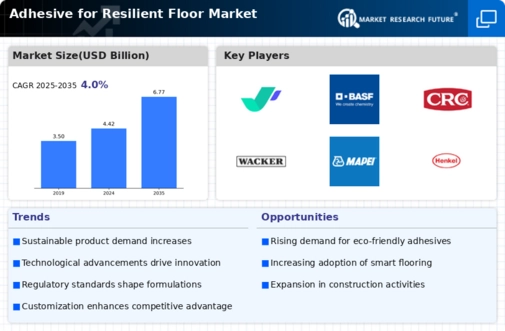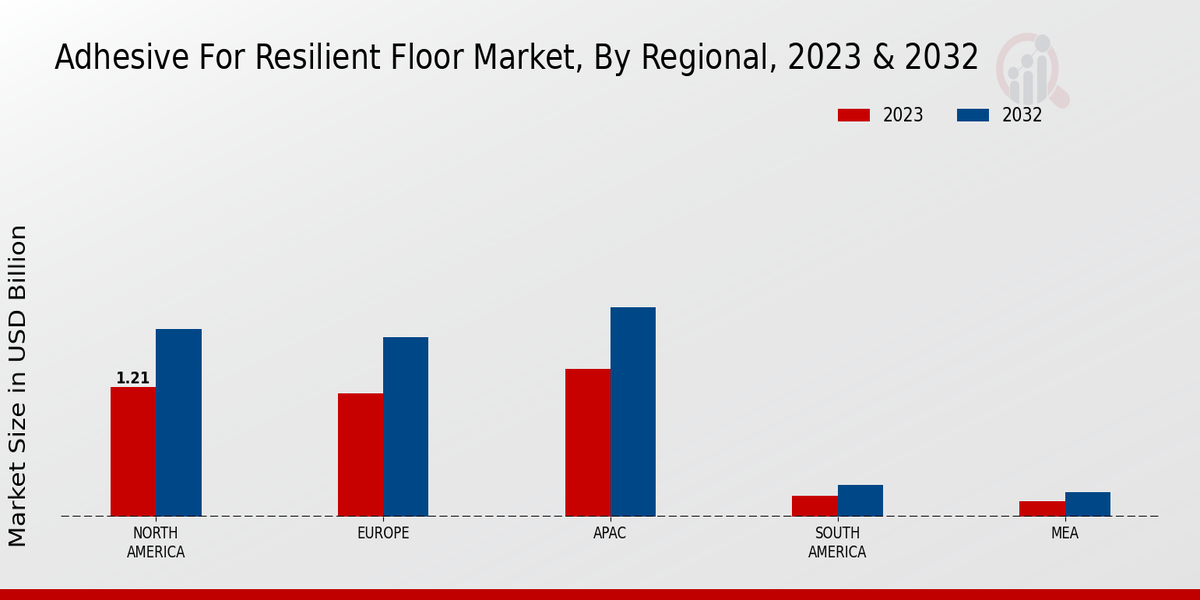Market Growth Projections
The Global Adhesive for Resilient Floor Market Industry is projected to experience substantial growth over the next decade. With an estimated market value of 4.42 USD Billion in 2024, the industry is expected to reach approximately 6.77 USD Billion by 2035. This growth trajectory suggests a compound annual growth rate of 3.95% from 2025 to 2035. Such projections indicate a robust demand for adhesives, driven by factors such as technological advancements, regulatory support for sustainable products, and the expansion of the construction sector. These metrics highlight the potential for investment and innovation within the industry, making it an attractive sector for stakeholders.
Expansion of the Construction Sector
The expansion of the global construction sector is a crucial driver for the Global Adhesive for Resilient Floor Market Industry. With urbanization and infrastructure development on the rise, the demand for resilient flooring solutions is expected to increase substantially. This growth is particularly evident in emerging economies, where investments in residential and commercial projects are surging. As the construction industry continues to evolve, the need for high-quality adhesives that can support various flooring applications becomes paramount. The anticipated market value of 6.77 USD Billion by 2035 underscores the potential for growth driven by this sector, highlighting the importance of adhesives in modern construction practices.
Growing Demand for Resilient Flooring
The increasing preference for resilient flooring solutions in residential and commercial spaces appears to be a primary driver for the Global Adhesive for Resilient Floor Market Industry. As consumers seek durable, low-maintenance, and aesthetically pleasing flooring options, the demand for adhesives that can effectively bond these materials is likely to rise. This trend is supported by the projected market value of 4.42 USD Billion in 2024, indicating a robust growth trajectory. The shift towards sustainable and eco-friendly flooring options further emphasizes the necessity for high-performance adhesives, which are essential for ensuring longevity and performance in various applications.
Rising Awareness of Indoor Air Quality
The growing awareness of indoor air quality is becoming a significant driver for the Global Adhesive for Resilient Floor Market Industry. Consumers and businesses alike are increasingly concerned about the health implications of indoor environments, leading to a preference for low-emission adhesives that contribute to better air quality. This trend is particularly relevant in commercial spaces such as offices, schools, and healthcare facilities, where air quality is paramount. As the demand for healthier indoor environments continues to rise, manufacturers are likely to focus on developing adhesives that meet these criteria, thereby expanding their market share and contributing to overall industry growth.
Regulatory Support for Sustainable Products
Regulatory frameworks promoting sustainability are increasingly shaping the Global Adhesive for Resilient Floor Market Industry. Governments worldwide are implementing stringent regulations aimed at reducing environmental impact, which encourages manufacturers to develop eco-friendly adhesive solutions. This shift towards sustainability not only meets regulatory requirements but also aligns with consumer preferences for greener products. As a result, the market is likely to see a rise in demand for adhesives that are low in volatile organic compounds and made from renewable resources. This trend could further enhance the market's growth prospects, as companies adapt to these evolving regulations and consumer expectations.
Technological Advancements in Adhesive Formulations
Innovations in adhesive formulations are significantly influencing the Global Adhesive for Resilient Floor Market Industry. Manufacturers are increasingly investing in research and development to create adhesives that offer superior bonding capabilities, faster curing times, and enhanced resistance to moisture and temperature fluctuations. These advancements not only improve the performance of resilient flooring but also align with the growing demand for sustainable products. As a result, the market is expected to witness a compound annual growth rate of 3.95% from 2025 to 2035, reflecting the industry's commitment to innovation and quality. This focus on technology is likely to attract new players and expand the market further.





















Leave a Comment